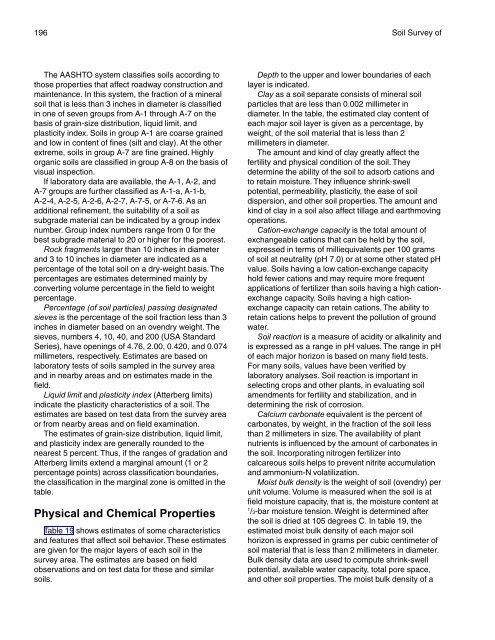Soil Survey of McHenry County, Illinois Part I - Soil Data Mart
Soil Survey of McHenry County, Illinois Part I - Soil Data Mart
Soil Survey of McHenry County, Illinois Part I - Soil Data Mart
You also want an ePaper? Increase the reach of your titles
YUMPU automatically turns print PDFs into web optimized ePapers that Google loves.
196 <strong>Soil</strong> <strong>Survey</strong> <strong>of</strong><br />
The AASHTO system classifies soils according to<br />
those properties that affect roadway construction and<br />
maintenance. In this system, the fraction <strong>of</strong> a mineral<br />
soil that is less than 3 inches in diameter is classified<br />
in one <strong>of</strong> seven groups from A-1 through A-7 on the<br />
basis <strong>of</strong> grain-size distribution, liquid limit, and<br />
plasticity index. <strong>Soil</strong>s in group A-1 are coarse grained<br />
and low in content <strong>of</strong> fines (silt and clay). At the other<br />
extreme, soils in group A-7 are fine grained. Highly<br />
organic soils are classified in group A-8 on the basis <strong>of</strong><br />
visual inspection.<br />
If laboratory data are available, the A-1, A-2, and<br />
A-7 groups are further classified as A-1-a, A-1-b,<br />
A-2-4, A-2-5, A-2-6, A-2-7, A-7-5, or A-7-6. As an<br />
additional refinement, the suitability <strong>of</strong> a soil as<br />
subgrade material can be indicated by a group index<br />
number. Group index numbers range from 0 for the<br />
best subgrade material to 20 or higher for the poorest.<br />
Rock fragments larger than 10 inches in diameter<br />
and 3 to 10 inches in diameter are indicated as a<br />
percentage <strong>of</strong> the total soil on a dry-weight basis. The<br />
percentages are estimates determined mainly by<br />
converting volume percentage in the field to weight<br />
percentage.<br />
Percentage (<strong>of</strong> soil particles) passing designated<br />
sieves is the percentage <strong>of</strong> the soil fraction less than 3<br />
inches in diameter based on an ovendry weight. The<br />
sieves, numbers 4, 10, 40, and 200 (USA Standard<br />
Series), have openings <strong>of</strong> 4.76, 2.00, 0.420, and 0.074<br />
millimeters, respectively. Estimates are based on<br />
laboratory tests <strong>of</strong> soils sampled in the survey area<br />
and in nearby areas and on estimates made in the<br />
field.<br />
Liquid limit and plasticity index (Atterberg limits)<br />
indicate the plasticity characteristics <strong>of</strong> a soil. The<br />
estimates are based on test data from the survey area<br />
or from nearby areas and on field examination.<br />
The estimates <strong>of</strong> grain-size distribution, liquid limit,<br />
and plasticity index are generally rounded to the<br />
nearest 5 percent. Thus, if the ranges <strong>of</strong> gradation and<br />
Atterberg limits extend a marginal amount (1 or 2<br />
percentage points) across classification boundaries,<br />
the classification in the marginal zone is omitted in the<br />
table.<br />
Physical and Chemical Properties<br />
Table 19 shows estimates <strong>of</strong> some characteristics<br />
and features that affect soil behavior. These estimates<br />
are given for the major layers <strong>of</strong> each soil in the<br />
survey area. The estimates are based on field<br />
observations and on test data for these and similar<br />
soils.<br />
Depth to the upper and lower boundaries <strong>of</strong> each<br />
layer is indicated.<br />
Clay as a soil separate consists <strong>of</strong> mineral soil<br />
particles that are less than 0.002 millimeter in<br />
diameter. In the table, the estimated clay content <strong>of</strong><br />
each major soil layer is given as a percentage, by<br />
weight, <strong>of</strong> the soil material that is less than 2<br />
millimeters in diameter.<br />
The amount and kind <strong>of</strong> clay greatly affect the<br />
fertility and physical condition <strong>of</strong> the soil. They<br />
determine the ability <strong>of</strong> the soil to adsorb cations and<br />
to retain moisture. They influence shrink-swell<br />
potential, permeability, plasticity, the ease <strong>of</strong> soil<br />
dispersion, and other soil properties. The amount and<br />
kind <strong>of</strong> clay in a soil also affect tillage and earthmoving<br />
operations.<br />
Cation-exchange capacity is the total amount <strong>of</strong><br />
exchangeable cations that can be held by the soil,<br />
expressed in terms <strong>of</strong> milliequivalents per 100 grams<br />
<strong>of</strong> soil at neutrality (pH 7.0) or at some other stated pH<br />
value. <strong>Soil</strong>s having a low cation-exchange capacity<br />
hold fewer cations and may require more frequent<br />
applications <strong>of</strong> fertilizer than soils having a high cationexchange<br />
capacity. <strong>Soil</strong>s having a high cationexchange<br />
capacity can retain cations. The ability to<br />
retain cations helps to prevent the pollution <strong>of</strong> ground<br />
water.<br />
<strong>Soil</strong> reaction is a measure <strong>of</strong> acidity or alkalinity and<br />
is expressed as a range in pH values. The range in pH<br />
<strong>of</strong> each major horizon is based on many field tests.<br />
For many soils, values have been verified by<br />
laboratory analyses. <strong>Soil</strong> reaction is important in<br />
selecting crops and other plants, in evaluating soil<br />
amendments for fertility and stabilization, and in<br />
determining the risk <strong>of</strong> corrosion.<br />
Calcium carbonate equivalent is the percent <strong>of</strong><br />
carbonates, by weight, in the fraction <strong>of</strong> the soil less<br />
than 2 millimeters in size. The availability <strong>of</strong> plant<br />
nutrients is influenced by the amount <strong>of</strong> carbonates in<br />
the soil. Incorporating nitrogen fertilizer into<br />
calcareous soils helps to prevent nitrite accumulation<br />
and ammonium-N volatilization.<br />
Moist bulk density is the weight <strong>of</strong> soil (ovendry) per<br />
unit volume. Volume is measured when the soil is at<br />
field moisture capacity, that is, the moisture content at<br />
1 /3-bar moisture tension. Weight is determined after<br />
the soil is dried at 105 degrees C. In table 19, the<br />
estimated moist bulk density <strong>of</strong> each major soil<br />
horizon is expressed in grams per cubic centimeter <strong>of</strong><br />
soil material that is less than 2 millimeters in diameter.<br />
Bulk density data are used to compute shrink-swell<br />
potential, available water capacity, total pore space,<br />
and other soil properties. The moist bulk density <strong>of</strong> a

















